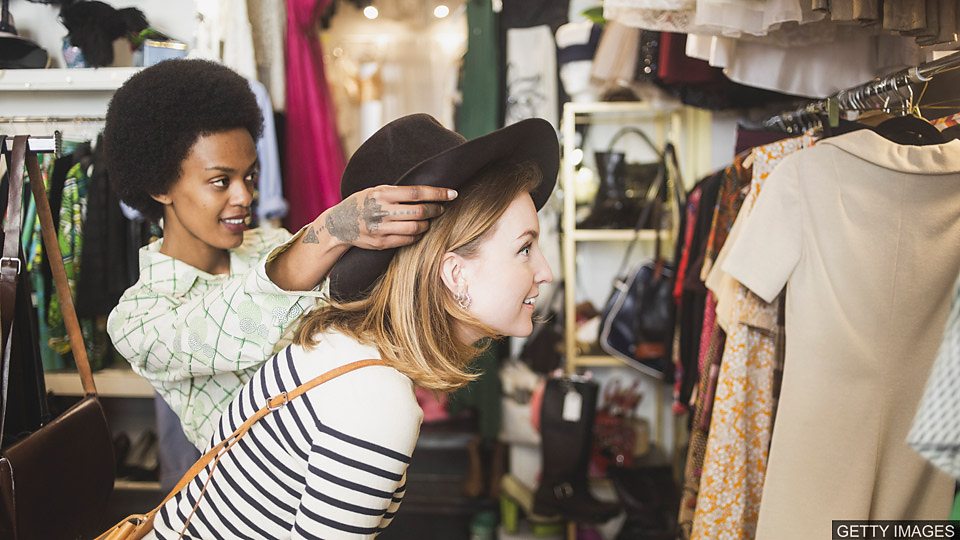
随身英语
Second-hand clothes and reducing your fashion footprint 买二手衣服 减少你的时尚碳足迹
越来越多的消费者选择购买二手衣物,他们认为这样做更环保。这种购物习惯的改变也在迫使时尚行业发生改变。本文讨论消费者应如何减少自己的时尚碳足迹。
词汇:fashion 时尚
The destructive impact of fast fashion on the environment is widely documented. So how can we, as consumers, reduce our fashion footprint? One obvious answer is to buy less. Another is to buy clothes that have been more sustainably made, using organic and recycled materials. Hiring clothes is another way to get new pieces for our wardrobe. But buying second-hand may be the simplest solution and a trend that is growing fast.
According to the Boston Consulting Group, second-hand clothes are projected to make up 27 per cent of customers’ wardrobes by 2023. By 2030, the second-hand clothing market is projected to be twice the size of fast fashion, according to a global report by Thredup and GlobalData. So, it seems, the next ten years will see the resale market grow fast, and this is in part because we now have more options than simply buying from charity shops and jumble sales. Online sites are making it easier to both buy and sell pre-loved items.
It also helps that the perception of pre-loved clothing has changed. Dr Amna Khan, senior lecturer in consumer behaviours and retail at Manchester Metropolitan University, said ‘it’s now become trendy to wear second-hand’ and it’s no longer ‘a case of only buying it if you can’t afford anything else’. The changing values of shoppers is even being seen in celebrity culture, with television personalities, such as contestants on the popular UK TV show Love Island, promoting second-hand clothing.
Not everyone is convinced that these changes in shopping habits will do enough to reduce our fashion footprint. The charity Wrap tells people to repair and revamp clothes they already have in their wardrobe before buying new ones, even if they are second-hand. But it’s clear that some consumers now want to consume less and make more environmentally friendly choices when they do buy. The fashion industry is therefore having to change, and the second-hand market is the star of the show.
词汇表
destructive impact on 破坏性的影响
consumer 消费者
fashion footprint 时尚碳足迹
sustainably 可持续地
hire (an item) 租用,租借
wardrobe 衣柜,衣橱
trend 趋势
project (v) 预计
fast fashion 快速时尚
resale market 二手市场
charity shop 慈善商店
jumble sale 旧货义卖
pre-loved item 二手物品
retail 零售
trendy 时髦的
value (n) 观念
celebrity culture 名人文化
repair 修补
revamp 修改,翻新
测验与练习
1. 阅读课文并回答问题。
1. Is buying second-hand the only solution to reducing our fashion footprint?
2. True or False? By 2030, fast fashion will be half the size of the second-hand clothing market.
3. Before buying online, where did consumers go to buy second-hand clothes?
4. True or False? People now only buy second-hand if they can’t afford anything else.
5. Who is causing the change in shopping habits – the consumer or the fashion industry?
2. 选择意思恰当的单词或词组来完成下列句子。
1. In my family we grow our own fruit and vegetables to live more _______.
widely sustainably trendy consumer
2. It’s going to snow tomorrow, _______ the weather forecast.
impact on widely documented according to perception
3. It is true that women _______ less than forty per cent of people working in science?
revamp project make up destructive impact on
4. Toby has his own style. He doesn’t care what’s _______ at the moment.
trendy trend value fashion footprint
5. My mother wasn’t _______ when I told her I had finished my homework.
promoted convinced repaired revamped
答案
1. 阅读课文并回答问题。
1. Is buying second-hand the only solution to reducing our fashion footprint?
No, other possible solutions are: buying less, buying clothes that have been more sustainably made, hiring clothes, and repairing and revamping clothes.
2. True or False? By 2030, fast fashion will be half the size of the second-hand clothing market.
True. By 2030, the second-hand clothing market is projected to be twice the size of fast fashion.
3. Before buying online, where did consumers go to buy second-hand clothes?
Charity shops and jumble sales.
4. True or False? People now only buy second-hand if they can’t afford anything else.
False. The perception of second-hand clothing has changed and it’s become trendy.
5. Who is causing the change in shopping habits – the consumer or the fashion industry?
The consumer. Consumers want to consume less and make more environmentally friendly choices when they buy, so the fashion industry is having to change.
2. 选择意思恰当的单词或词组来完成下列句子。
1. In my family we grow our own fruit and vegetables to live more sustainably.
2. It’s going to snow tomorrow, according to the weather forecast.
3. It is true that women make up less than forty per cent of people working in science?
4. Toby has his own style. He doesn’t care what’s trendy at the moment.
5. My mother wasn’t convinced when I told her I had finished my homework.



